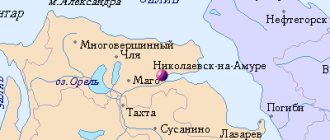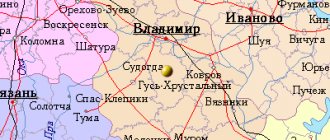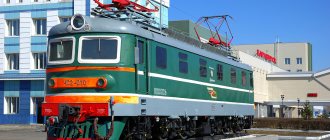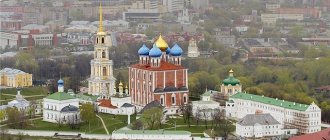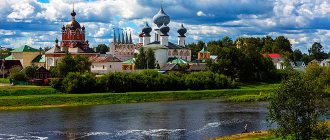City in Volgograd Oblast, Russia
| Zhirnovsk Zhirnovsk | |
| City [1] | |
| Lomonosova Street in the center of Zhirnovsk | |
| Flag Coat of arms | |
| Location Zhirnovsk | |
| Zhirnovsk Location Zhirnovsk Show map of Russia Zhirnovsk Zhirnovsk (Volgograd region) Show map of Volgograd region | |
| Coordinates: 50°59'N 44°47'E / 50.983°N Latitude 44.783°E / 50.983; 44.783 Coordinates: 50°59'N 44°47'E. / 50.983°N Latitude 44.783°E / 50.983; 44,783 | |
| A country | Russia |
| Federal subject | Volgograd region [1] |
| Administrative region | Zhirnovsky district [1] |
| City of district significance | Zhirnovsk [2] |
| Based | 1958 |
| Height | 120 m (390 ft) |
| population size (2010 Census) [3] | |
| • General | 16 872 |
| • Evaluate (2018) [4] | 15680 ( -7,1% ) |
| Administrative status | |
| • Capital from | Zhirnovsky district [1], city of district significance Zhirnovsk [2] |
| Municipal status | |
| • Municipal district | Zhirnovsky municipal district [5] |
| • Urban village | Zhirnovskoye urban settlement [5] |
| • Capital from | Zhirnovsky municipal district [5], urban settlement of Zhirnovskoye [5] |
| Timezone | UTC+4 (MSK+1[6]) |
| Postal code [7] | 403790–403793 |
| Dialing code(s) | +7 84454 |
| OKTMO ID | 18612101001 |
| Web site | www.jirnovsk.ru |
Zhirnovsk
(Russian: Zhirnovsk) is a city and administrative center of Zhirnovsky District in Volgograd Oblast, Russia, located on the left bank of the Medveditsa River, which itself flows into the Don. Zhirnovsk is located 320 km north of Volgograd, the administrative center of the region. Population: 16,872 (2010 census); [3] 17,751 (2002 census); [8] 16,792 (1989 census). [9]
Links[edit]
Notes[edit]
- ^ abcde State Committee of the Russian Federation on Statistics. Committee of the Russian Federation for Standardization, Metrology and Certification. No. OK 019-95 January 1, 1997 “All-Russian classifier of objects of administrative-territorial division. Code 18 212", ed. changes No. 278 / 2015 dated January 1, 2016. (Goskomstat of the Russian Federation. Committee of the Russian Federation for Standardization, Metrology and Certification. No. OK 019-95 January 1, 1997. Russian classification of administrative divisions) (OKATO).
Code 18 212 as amended by Amendment No. 278/2015 dated 01/01/2016). - ^ abc State Committee of the Russian Federation on Statistics. Committee of the Russian Federation for Standardization, Metrology and Certification. No. OK 019-95 January 1, 1997 “All-Russian classifier of objects of administrative-territorial division. Code 18 212 501", as amended. changes No. 278 / 2015 dated January 1, 2016. (Goskomstat of the Russian Federation. Committee of the Russian Federation for Standardization, Metrology and Certification. No. OK 019-95 January 1, 1997. Russian classification of administrative divisions) (OKATO).
Code 18 212 501 , as amended by Amendment No. 278/2015 of January 1, 2016). - ^ a b Federal State Statistics Service (2011). “All-Russian Population Census 2010. Volume 1" [All-Russian Population Census 2010, vol. 1]. All-Russian Population Census 2010 [All-Russian Population Census 2010]
. Federal State Statistics Service. - "26. The size of the permanent population of the Russian Federation by municipalities as of January 1, 2022". Federal State Statistics Service. Retrieved January 23, 2022.
- ^ abcde Law No. 1009-OD
- "On the Calculation of Time". Official Internet portal of legal information
. June 3, 2011. Retrieved January 19, 2022. - Post office. Information and computing center of OASU RPO. ( Post office
).
Search for postal service objects ( postal Search for objects
) (in Russian) - ↑
Federal State Statistics Service of Russia (May 21, 2004).
“The population of Russia, the constituent entities of the Russian Federation as part of federal districts, urban settlements, settlements, settlements is 3 thousand or more people” [Population of Russia, its federal districts, federal districts, districts Urban settlements, rural settlements - administrative centers and rural settlements with a population of over 3,000] (XLS). All-Russian Population Census 2002
. - “All-Union Population Census of 1989. The current population of union and autonomous republics, autonomous regions and districts, territories, negative phenomena, urban settlements and rural district centers” [All-Union Population Census of 1989: current population of union and autonomous republics, Autonomous regions and districts , territories, regions, districts, urban settlements and villages performing the functions of district administrative centers. All-Union Population Census of 1989 [All-Union Population Census of 1989]
.
Institute of Demography of the National Research University: Higher School of Economics [Institute of Demography of the National Research University: Higher School of Economics]. 1989 - via Demoscope Weekly
.
Zhirnovsk
(Volgograd region)
OKATO code:
18212501
Founded: Urban settlement since:
1954
City since:
1958 City of district subordination (Zhirnovsky district, Volgograd region)
Center:
Zhirnovsky district
The city was formerly called:
| Bold | 1954 | |
| Zhirnovsky | 1954 | 1958 |
| Telephone code (reference phone) | |
| 84454***** | |
| 844542**** | |
Deviation from Moscow time, hours:
0
Geographic latitude:
50°59′
Geographic longitude:
44°46′
Altitude above sea level, meters:
120 Sunrise and sunset times of the Sun and Moon in the city of Zhirnovsk
Attractions
- Temple of the Holy Spirit-Comforter
- Zhirnovsky District House of Culture
- Park of Culture and Recreation
- Komsomolsky Park
- Monument to fellow countrymen
- 40th Anniversary of Victory Park
- Cross on the TV Tower
- Blue Mountain tract
- Monument to V.I. Lenin (Near RDK)
Map
| Zhirnovsk: maps |
Zhirnovsk: photo from space (Google Maps) Zhirnovsk: photo from space (Microsoft Virtual Earth)
| Zhirnovsk. Nearest cities. Distances in km. on the map (in brackets along roads) + direction. Using the hyperlink in the distance , you can get the route (information courtesy of the AutoTransInfo website) | |||
| 1 | Linevo | 11 (13) | YU |
| 2 | Rudnya | 25 (23) | SW |
| 3 | Krasny Yar | 31 (39) | YU |
| 4 | Kalininsk | 60 (71) | WITH |
| 5 | Bald Mountains (Saratov region) | 63 (95) | WITH |
| 6 | Krasnoarmeysk | 65 (254) | IN |
| 7 | Yelan | 72 (78) | Z |
| 8 | Kotovo | 74 (83) | YU |
| 9 | Samoilovka (Saratov region) | 76 (103) | Z |
| 10 | Danilovka | 83 (151) | SW |
| 11 | Rovnoe (Saratov region) | 92 (290) | IN |
| 12 | Tatishchevo (Saratov region) | 96 (187) | NE |
| 13 | Svetly (Saratov region) | 96 (191) | NE |
| 14 | Sokolovy (Saratov region) | 98 (184) | NE |
| 15 | Petrov Val | 99 (120) | YU |
| 16 | Atkarsk | 100 (182) | WITH |
| 17 | Privolzhsky (Saratov region) | 101 (202) | NE |
| 18 | Saratov | 107 (174) | NE |
| 19 | Kamyshin | 109 (142) | SE |
| 20 | Engels | 110 (189) | NE |
| 21 | Nikolaevsk | 117 (156) | SE |
a brief description of
Located in the southern part of the Volga Upland, on the left bank of the river. Medveditsa (Don basin), 27 km north of the railway. Medveditsa station, 320 km north of Volgograd.
Territory (sq. km): 92
Information about the city of Zhirnovsk on the Russian Wikipedia site
Historical sketch
Until 1954 - the village of Zhirnoye. Since 1954 - the working village of Zhirnovsky. City of Zhirnovsk since 1958
The primary name is presumably associated with oil seeps.
Economy
Mining of oil and gas. Asphalt concrete plant, bakery, food processing plant.
Main enterprises
OIL PRODUCTION INDUSTRY
Zhirnovsky oil refining department of OJSC "Lukoil-Nizhnevolzhskneft"
403760, Volgograd region, Zhirnovsky district, Zhirnovsk, st.
Matrosova, 20 Offers:
oil, natural gas
Culture, science, education
Museum of History and Local Lore.
| Population by year (thousands of inhabitants) | |||||||
| 1959 | 9.9 | 2000 | 19.1 | 2010 | 16.1 | 2017 | 15.9 |
| 1970 | 14.7 | 2001 | 19.0 | 2011 | 16.9 | 2018 | 15.7 |
| 1979 | 15.7 | 2003 | 17.8 | 2012 | 16.7 | 2019 | 15.5 |
| 1989 | 16.8 | 2005 | 17.2 | 2013 | 16.6 | 2020 | 15.5 |
| 1992 | 17.5 | 2006 | 16.9 | 2014 | 16.4 | 2021 | 15.3 |
| 1996 | 19.0 | 2007 | 16.7 | 2015 | 16.2 | ||
| 1998 | 19.2 | 2008 | 16.5 | 2016 | 16.1 | ||
Gorodishchensky district
The shield of this coat of arms is painted blue. In the center is a silver eagle, which holds in its paws a golden fortress with five star-shaped bastions. Inside the outline on a red background there is a key and a sword crossed with ash - these are the personal attributes of Peter the Great, and the fortress was founded by him.
Above the bird there are three golden flowers - three urban settlements. On the sides of the eagle there are bunches of wheat ears, their number corresponds to the number of municipal centers. The eagle itself symbolizes superiority over evil forces and the height of the spirit.
The Zhirnovsky municipal district of the Volgograd region is located in its north-eastern part, in the subzone of dark chestnut steppes, on both sides of the Medveditsa , which flows into the Don. In the north and east, the region borders on the Krasnoarmeysky and Kalininsky districts of the Saratov region, in the south - on Kotovsky and Kamyshinsky, in the west - on the Rudnyansky and Elansky districts of the Volgograd region. The district includes Zhirnovsky city, Krasnoyarsk, Linevsky, Medveditsky settlements and 11 rural councils, uniting 38 settlements. The regional center is the city of Zhirnovsk .
The occupied area is 2,971 sq. km. Population: 43.6 thousand people.
In the 16th-18th centuries, the lands here were considered courtyards. They were divided into grooms and given as rent to honey collectors, beaver hunters, fishermen, and salt producers. Individual members of the royal family were assigned guards to receive income from them. Thus, L.K. Naryshkin was granted 777 side ports along the Khoprer , Medveditsa , Vorone , and Elani .
The first free settlers in this region were fugitive people from central Russia; fugitive Chuvash, Mordovians, and Tatars from the former Kazan kingdom, persecuted by the tyranny of the landowners and forced Christianization, also rushed here.
In the last years of the 19th century, the Kamyshin-Moscow railway (1893-1894) and two stations Adadurovo and Medveditsa were built in the area. The settlements of the region before 1917, and also after, until 1928, were part of the Kamyshinsky district of the Saratov province (then the Lower Volga region).
In 1917, 70,608 residents lived in the district. 29 schools were opened in the villages, in which 93 teachers taught peasant children. In every major settlement there is a church, the Sazhnovsky monastery for 120 nuns (4 km from the village of Vishnevoye), as well as 18 taverns.
In 1919, the cavalry corps of Semyon Mikhailovich Budyonny was located in the villages of the region, whose headquarters were located in one of the houses in the village of Verkhnyaya Dobrinka (now the post office building).
In 1928, zoning was carried out in the region - Krasnoyarsk, Rudnyansky, and then Netkachevsky and Lemeshkinsky districts were formed. The territories of the current Aleshnikovsky, Novinsky, Medveditsky rural and Linevsky village Soviets until September 1941 were part of the Frankovsky and then Gussenbach cantons of the Autonomous Soviet Socialist Republic of the Volga Germans with the center - the city of Gussenbach, whose population in 1941 was 12,500 people, now the village of Linevo.
With the formation of the Stalingrad Territory on January 10, 1934, which was transformed into the Stalingrad Region on December 5, 1934, the territory of the district became part of it. On November 10, 1961, the region was renamed Volgograd.
In April 1942, after the liquidation of the Volga German Republic, by decree of the Presidium of the Supreme Soviet of the RSFSR, the Medveditsky district was formed, on the territory of which collective farms evacuated from the western regions of the country were located.
The formation of the district took place over two decades - from 1942 to 1964. Before that, its main part was part of the Autonomous Republic of the Volga Germans, as evidenced by historical monuments of that time, for example, the German church in the village of Grechikhino, the Barelskaya mill near the Medveditsa station of the Volga Railway.
In the spring of 1949, the area experienced a “rebirth.” On the outskirts of the village of Zhirnoye, thanks to the drillers and oil pioneers, a powerful fountain of oil hit the sky, heralding the beginning of industrial oil production in the Lower Volga region.
In 1954, Nizhnedobrinsky and Medveditsky rural councils were transferred to the Medveditsky district from Krasnoyarsk, and in 1959, after the liquidation of the Lemeshkinsky district - Klenovsky, Aleksandrovsky and Tarapatinsky rural councils.
In August 1959, by decree of the Presidium of the Supreme Soviet of the RSFSR, the Medveditsky district was transformed into Zhirnovsky .
In 1962, the Krasnoyarsk, Rudnyansky and Zhirnovsky districts were united into one - Zhirnovsky, but in 1965 the Rudnyansky district was restored, after which the territory and borders of the Zhirnovsky district did not change.
Zhirnovsky district belongs to the cool agroclimatic region of the arid region. The average annual air temperature is 5.5 degrees. The hottest months are July and August. Air temperature 20 – 22 degrees. The absolute maximum temperature is 41 – 42 degrees. The duration of the frost-free period is 148 – 153 days. Negative features of the climate are frosts. During the warm period of the year, strong easterly winds turn into dry winds and dust storms.
The continuation of the Guselsko-Tetervyatsky ridge is the Blue Mountain, which crosses the area in the northeast direction. Rare species of forest plants grow in this zone of the region: buttercup anemone, open lumbago, primrose, Siberian scilla; rare species of steppe flora: narrow-leaved and pubescent feather grass, thin-leaved peony, chamomile aster, etc.,
10 rivers flow through the region: Medveditsa , Shchelkan , Peskovatka , Lomovka , Dobrinka , Karamysh , Burluchok , Knyazevka , Klenovka , Perevozikha .
The fauna is diverse. In the foxes there are moose, roe deer, wild boars, and hares. Among the predatory animals: wolves, foxes, badgers, etc. The Teterevyatsky reserve is inhabited by black grouse, pheasants, partridges, red ducks and other birds.
The Moscow-Volgograd railway runs through the southwestern part of the region. There are two stations: Adadurovo and Medveditsa.
Among the archaeological monuments in the area, the following can be noted: excavations of 2 mounds near the city of Zhirnovsk , which, by the beginning of research, had disrupted the trenches of the oil collection and transportation pipelines. 11 burials of the Timber-frame culture of the Bronze Age, dated 1500-1250 BC, were discovered in them. e. In 1997, security and archaeological excavations of 2 mounds on the lands of Nizhnedobrinskoye LLP were carried out by the regional research and production center for the protection of historical and cultural monuments. The excavations were led by P.E. Zakharov. .One of the mounds contained the burial of a noble Sarmatian woman (1st century AD)
Another mound contained two burials from the late 13th early 14th century.
Official website of the district: www.admzhirn.ru
Excerpt characterizing Zhirnovsk
- You love him? “Yes,” Natasha whispered. -What are you crying about? “I’m happy for you,” said Princess Marya, having completely forgiven Natasha’s joy for these tears. – It won’t be soon, someday. Think about what happiness it will be when I become his wife and you marry Nicolas. – Natasha, I asked you not to talk about this. We'll talk about you. They were silent. - But why go to St. Petersburg! - Natasha suddenly said, and she quickly answered herself: - No, no, this is how it should be... Yes, Marie? This is how it should be... Seven years have passed since the 12th year. The troubled historical sea of Europe has settled into its shores. It seemed quiet; but the mysterious forces that move humanity (mysterious because the laws determining their movement are unknown to us) continued to operate. Despite the fact that the surface of the historical sea seemed motionless, humanity moved as continuously as the movement of time. Various groups of human connections formed and disintegrated; the reasons for the formation and disintegration of states and the movements of peoples were prepared. The historical sea, not as before, was directed by gusts from one shore to another: it seethed in the depths. Historical figures, not as before, rushed in waves from one shore to another; now they seemed to be spinning in one place. Historical figures, who previously at the head of troops reflected the movement of the masses with orders of wars, campaigns, battles, now reflected the seething movement with political and diplomatic considerations, laws, treatises... Historians call this activity of historical figures reaction. Describing the activities of these historical figures, who, in their opinion, were the cause of what they call the reaction, historians strictly condemn them. All famous people of that time, from Alexander and Napoleon to m me Stael, Photius, Schelling, Fichte, Chateaubriand, etc., are subject to their strict judgment and are acquitted or condemned, depending on whether they contributed to progress or reaction. In Russia, according to their description, a reaction also took place during this period of time, and the main culprit of this reaction was Alexander I - the same Alexander I who, according to their descriptions, was the main culprit of the liberal initiatives of his reign and the salvation of Russia. In real Russian literature, from a high school student to a learned historian, there is not a person who would not throw his own pebble at Alexander I for his wrong actions during this period of his reign. “He should have done this and that. In this case he acted well, in this case he acted badly. He behaved well at the beginning of his reign and during the 12th year; but he acted badly by giving a constitution to Poland, making the Holy Alliance, giving power to Arakcheev, encouraging Golitsyn and mysticism, then encouraging Shishkov and Photius. He did something wrong by being involved in the front part of the army; he acted badly by distributing the Semyonovsky regiment, etc.” It would be necessary to fill ten pages in order to list all the reproaches that historians make to him on the basis of the knowledge of the good of humanity that they possess. What do these reproaches mean? The very actions for which historians approve of Alexander I, such as: the liberal initiatives of his reign, the fight against Napoleon, the firmness he showed in the 12th year, and the campaign of the 13th year, do not stem from the same sources - the conditions of blood , education, life, which made Alexander’s personality what it was - from which flow those actions for which historians blame him, such as: the Holy Alliance, the restoration of Poland, the reaction of the 20s? What is the essence of these reproaches? The fact that such a historical person as Alexander I, a person who stood at the highest possible level of human power, is, as it were, in the focus of the blinding light of all the historical rays concentrated on him; a person subject to those strongest influences in the world of intrigue, deception, flattery, self-delusion, which are inseparable from power; a face that felt, every minute of its life, responsibility for everything that happened in Europe, and a face that is not fictitious, but living, like every person, with its own personal habits, passions, aspirations for goodness, beauty, truth - that this face , fifty years ago, not only was he not virtuous (historians do not blame him for this), but he did not have those views for the good of humanity that a professor now has, who has been engaged in science from a young age, that is, reading books, lectures and copying these books and lectures in one notebook. But even if we assume that Alexander I fifty years ago was mistaken in his view of what is the good of peoples, we must involuntarily assume that the historian judging Alexander, in the same way, after some time will turn out to be unjust in his view of that , which is the good of humanity. This assumption is all the more natural and necessary because, following the development of history, we see that every year, with every new writer, the view of what is the good of humanity changes; so that what seemed good appears after ten years as evil; and vice versa. Moreover, at the same time we find in history completely opposite views on what was evil and what was good: some take credit for the constitution given to Poland and the Holy Alliance, others as a reproach to Alexander. It cannot be said about the activities of Alexander and Napoleon that they were useful or harmful, because we cannot say for what they are useful and for what they are harmful. If someone does not like this activity, then he does not like it only because it does not coincide with his limited understanding of what is good. Does it seem good to me to preserve my father’s house in Moscow in 12, or the glory of the Russian troops, or the prosperity of St. Petersburg and other universities, or the freedom of Poland, or the power of Russia, or the balance of Europe, or a certain kind of European enlightenment - progress, I must admit that the activity of every historical figure had, in addition to these goals, other, more general goals that were inaccessible to me. But let us assume that so-called science has the ability to reconcile all contradictions and has an unchanging measure of good and bad for historical persons and events. Let's assume that Alexander could have done everything differently. Let us assume that he could, according to the instructions of those who accuse him, those who profess knowledge of the ultimate goal of the movement of mankind, order according to the program of nationality, freedom, equality and progress (there seems to be no other) that his current accusers would have given him. Let us assume that this program was possible and drawn up and that Alexander would act according to it. What would then happen to the activities of all those people who opposed the then direction of the government - with activities that, according to historians, were good and useful? This activity would not exist; there would be no life; nothing would have happened. If we assume that human life can be controlled by reason, then the possibility of life will be destroyed. If we assume, as historians do, that great people lead humanity to achieve certain goals, which consist either in the greatness of Russia or France, or in the balance of Europe, or in spreading the ideas of revolution, or in general progress, or whatever it may be, it is impossible to explain the phenomena of history without the concepts of chance and genius. If the goal of the European wars at the beginning of this century was the greatness of Russia, then this goal could be achieved without all the previous wars and without an invasion. If the goal is the greatness of France, then this goal could be achieved without revolution and without empire. If the goal is the dissemination of ideas, then printing would accomplish this much better than soldiers. If the goal is the progress of civilization, then it is very easy to assume that, besides the extermination of people and their wealth, there are other more expedient ways for the spread of civilization. Why did it happen this way and not otherwise? Because that's how it happened. “Chance made the situation; genius took advantage of it,” says history. But what is a case? What is a genius? The words chance and genius do not mean anything that really exists and therefore cannot be defined. These words only denote a certain degree of understanding of phenomena. I don't know why this phenomenon happens; I don't think I can know; That’s why I don’t want to know and say: chance. I see a force producing an action disproportionate to universal human properties; I don’t understand why this happens, and I say: genius.
Dubovsky district
On the blue background of the Dubovsky coat of arms, there is a golden oak tree in the center. It is symmetrical, and its leaves are collected in constellations. There are plows to the right and left of the oak tree, but only half of them. It seems that they are floating out of the edges of the coat of arms.
There is a cannon on the bow of the boats as a symbol of the protection of the goods they transport. Below them is a yellow stripe. It denotes the Volga-Don-Volga route, a trade route that has existed for centuries.
Ilovlinsky district
The coat of arms of this region depicts a running deer in gold. A golden arrow flies into his back. There is a wide wavy gold line under the animal’s feet, and a thinner silver line just above it.
The meaning of the coat of arms is quite simple. According to one version, the name of the area comes from the words “silt” and “fishing”. Silt is depicted in the form of wavy lines, and fishing, that is, hunting is expressed in the form of a deer and a flying arrow.
Socio-cultural sphere
The city has: a nursing home, a hospital town, a sanatorium, and an air/railway ticket office.
Education
Kindergartens
- Preschool educational institution MDS No. 2 “Topolek”, Zhirnovsk
- Preschool educational institution MDS No. 3 “Solnyshko”, Zhirnovsk
- Preschool educational institution MDS No. 4 “Zvezdochka”, Zhirnovsk
- Preschool educational institution MDS No. 5 “Ivushka”, Zhirnovsk
- Preschool educational institution MDS No. 6 “Malyshok”, Zhirnovsk
- Preschool educational institution MDS of general developmental type No. 7 “Rodnichok”, Zhirnovsk
- Preschool educational institution MDS No. 8 “Semitsvetik”, Zhirnovsk
- Preschool educational institution MDS of combined type No. 9 “Golden Key”, Zhirnovsk
Schools
- Municipal educational institution "Secondary school No. 1"
- Municipal educational institution "Secondary school No. 2"
- Municipal educational institution "Secondary school No. 3"
- Municipal educational institution "Secondary School No. 4" (Closes in the summer of 2015, students disperse to the remaining schools.)
- Municipal educational institution Evening (shift) secondary school in Zhirnovsk.
Secondary special educational institutions
- Zhirnovsky Pedagogical College
- Zhirnovsky Oil College
- Training
Institutions of additional education
- School of the Arts
- Center of children's creativity
Culture
Zhirnovsky District House of Culture
In 1959, the Neftyanik Palace of Culture was built in the young city. At that time, there were no such Palaces of Culture in any district of the region. Based on the results of his work in 2006, he was recognized as the best in the review competition “Club of the Year of the Volgograd Region”. Today in the RDC more than 40 specialists are engaged in cultural and leisure work. In total, there are 57 groups operating in the House of Culture, with 987 participants. In 2014 they renamed and hung a new sign to now become RDK (District House of Culture)
There is also a stadium, a sports and recreation center, libraries, and a local history museum.

